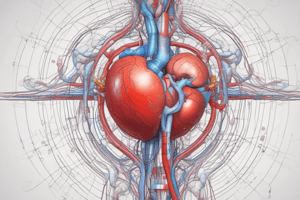Podcast
Questions and Answers
What is the primary enzymatic action of renin in the renin-angiotensin-aldosterone system (RAAS)?
What is the primary enzymatic action of renin in the renin-angiotensin-aldosterone system (RAAS)?
- Converting angiotensinogen into angiotensin I. (correct)
- Converting angiotensin I into angiotensin II.
- Inhibiting the production of ACE in the lungs.
- Directly stimulating aldosterone release from the adrenal cortex.
How does Angiotensin II contribute to the regulation of blood pressure during dehydration?
How does Angiotensin II contribute to the regulation of blood pressure during dehydration?
- By stimulating the release of atrial natriuretic hormone (ANH).
- By inhibiting aldosterone release to decrease sodium retention.
- By promoting vasodilation of renal arterioles to increase GFR.
- By reducing GFR and renal blood flow, limiting fluid loss. (correct)
What is the primary mechanism by which aldosterone increases blood pressure?
What is the primary mechanism by which aldosterone increases blood pressure?
- Increasing sodium excretion to reduce water retention.
- Inhibiting ADH release from the posterior pituitary.
- Promoting potassium reabsorption in the nephron.
- Promoting sodium reabsorption in the nephron, leading to water retention. (correct)
How does antidiuretic hormone (ADH) affect water reabsorption in the kidneys?
How does antidiuretic hormone (ADH) affect water reabsorption in the kidneys?
What is the primary effect of natriuretic hormones on sodium and water balance in the kidneys?
What is the primary effect of natriuretic hormones on sodium and water balance in the kidneys?
What is the role of ACE (Angiotensin-Converting Enzyme) in regulating blood pressure?
What is the role of ACE (Angiotensin-Converting Enzyme) in regulating blood pressure?
How do endothelins contribute to kidney dysfunction in individuals with diabetic kidney disease?
How do endothelins contribute to kidney dysfunction in individuals with diabetic kidney disease?
What is the primary trigger for the release of atrial natriuretic hormone (ANH)?
What is the primary trigger for the release of atrial natriuretic hormone (ANH)?
What is the primary function of parathyroid hormone (PTH) in the kidneys?
What is the primary function of parathyroid hormone (PTH) in the kidneys?
How does B-type natriuretic peptide (BNP) contribute to the regulation of blood pressure?
How does B-type natriuretic peptide (BNP) contribute to the regulation of blood pressure?
Which of the following is the mechanism by which diuretics lower blood pressure?
Which of the following is the mechanism by which diuretics lower blood pressure?
In what way does angiotensin II affect the glomerular filtration rate (GFR)?
In what way does angiotensin II affect the glomerular filtration rate (GFR)?
How does increased plasma $K^+$ directly influence hormone release related to renal function?
How does increased plasma $K^+$ directly influence hormone release related to renal function?
What is the effect of atrial natriuretic hormone (ANH) on the afferent and efferent arterioles of the glomerulus?
What is the effect of atrial natriuretic hormone (ANH) on the afferent and efferent arterioles of the glomerulus?
Why might individuals with high blood pressure be prescribed ACE inhibitors?
Why might individuals with high blood pressure be prescribed ACE inhibitors?
Progesterone is structurally similar to aldosterone; how does progesterone affect sodium and water balance?
Progesterone is structurally similar to aldosterone; how does progesterone affect sodium and water balance?
Which of the following scenarios would stimulate the release of renin from the juxtaglomerular apparatus (JGA)?
Which of the following scenarios would stimulate the release of renin from the juxtaglomerular apparatus (JGA)?
Endothelins are potent vasoconstrictors. What stimulates their release?
Endothelins are potent vasoconstrictors. What stimulates their release?
How does parathyroid hormone (PTH) influence calcium levels?
How does parathyroid hormone (PTH) influence calcium levels?
How does the body respond to over-stretching of the heart atria due to elevated blood pressure or heart failure?
How does the body respond to over-stretching of the heart atria due to elevated blood pressure or heart failure?
Flashcards
Renin
Renin
Enzyme produced by granular cells of the afferent arteriole at the JGA; converts angiotensinogen to angiotensin I.
Angiotensin-converting enzyme (ACE)
Angiotensin-converting enzyme (ACE)
Enzyme, produced in the lungs, that converts inactive angiotensin I into active angiotensin II, raising blood pressure.
Angiotensin II
Angiotensin II
A potent vasoconstrictor that reduces GFR and renal blood flow to limit fluid loss and preserve blood volume during blood loss or dehydration.
Aldosterone
Aldosterone
Signup and view all the flashcards
Diuretics
Diuretics
Signup and view all the flashcards
Antidiuretic Hormone (ADH)
Antidiuretic Hormone (ADH)
Signup and view all the flashcards
Endothelins
Endothelins
Signup and view all the flashcards
Natriuretic Hormones
Natriuretic Hormones
Signup and view all the flashcards
Atrial Natriuretic Hormone (ANH)
Atrial Natriuretic Hormone (ANH)
Signup and view all the flashcards
B-type Natriuretic Peptide (BNP)
B-type Natriuretic Peptide (BNP)
Signup and view all the flashcards
Parathyroid Hormone (PTH)
Parathyroid Hormone (PTH)
Signup and view all the flashcards
Study Notes
The Renin–Angiotensin–Aldosterone system regulates blood pressure and kidney function and is activated in response to low blood pressure, decreased blood sodium levels, and increased sympathetic nervous system activity.
Renin
- Renin is an enzyme produced by the granular cells of the afferent arteriole at the JGA (juxtaglomerular apparatus).
- Converts angiotensinogen (produced by the liver) into angiotensin I.
- Prostaglandins and NO from the JGA stimulate its release in response to decreased extracellular fluid volume.
Angiotensin-Converting Enzyme (ACE)
- ACE is produced in the lungs.
- ACE binds to endothelial cells in the afferent arterioles and glomerulus.
- ACE converts inactive angiotensin I into active angiotensin II.
- ACE raises blood pressure; ACE inhibitors are prescribed to lower blood pressure.
Angiotensin II
- Angiotensin II is a potent vasoconstrictor that regulates blood pressure.
- Angiotensin II constricts both the afferent and efferent arterioles of the glomerulus.
- In blood loss or dehydration, Angiotensin II reduces GFR and renal blood flow.
- Decreases in blood pressure usually stimulates its release, helps preserve adequate blood pressure.
Aldosterone
- Aldosterone is known as the "salt-retaining hormone."
- Aldosterone is released from the adrenal cortex stimulated by angiotensin II or increased plasma K+.
- Aldosterone promotes Na+ reabsorption in the nephron, promoting water retention.
- Aldosterone regulates K+ by promoting its excretion.
- It is a mineralocorticoid due to its dual effect on minerals and origin in the adrenal cortex.
- Renin has an immediate effect on blood pressure through angiotensin II-stimulated vasoconstriction.
- Renin has a prolonged effect through Na+ recovery due to aldosterone.
- Aldosterone increases Na+ recovery and increases K+ loss.
- Progesterone binds to the aldosterone receptor and weakly stimulates Na+ reabsorption and increased water recovery.
- Increased water retention occurs during the menstrual cycle due to increased progesterone levels in women.
Hypothermic dehydration response
Antidiuretic Hormone (ADH)
- Diuretics increase water loss by interfering with the recapture of solutes and water from forming urine.
- Diuretics are often prescribed to lower blood pressure.
- ADH is a 9-amino acid peptide released by the posterior pituitary.
- ADH promotes water recovery, decreases urine volume, and maintains plasma osmolarity and blood pressure.
- ADH stimulates the movement of aquaporin proteins into the apical cell membrane of principal cells of the collecting ducts.
- This forms water channels, allowing water movement from the collecting duct lumen into the kidney medulla.
- Water returns to circulation via the vasa recta capillaries due to the high osmotic environment in the kidney medulla.
Natriuretic Hormones
- Natriuretic hormones stimulate the kidneys to excrete sodium, opposing aldosterone's effect.
- Natriuretic hormones inhibit aldosterone release and Na+ recovery in the collecting ducts.
- If Na+ remains in forming urine, its osmotic force causes a concurrent loss of water.
- Natriuretic hormones inhibit ADH release, resulting in less water recovery.
- Therefore, natriuretic peptides inhibit both Na+ and water recovery.
- Atrial natriuretic hormone (ANH) is a 28-amino acid peptide produced by heart atria.
- ANH is released in response to over-stretching of the atrial wall, occurring in elevated blood pressure or heart failure.
- ANH increases GFR through vasodilation of the afferent arteriole and vasoconstriction of the efferent arteriole.
- ANH leads to increased loss of water and sodium in the forming urine.
- ANH decreases sodium reabsorption in the DCT.
- B-type natriuretic peptide (BNP) is a 32-amino acid peptide produced in the ventricles of the heart.
- BNP has a 10-fold lower affinity for its receptor, so its effects are less than those of ANH.
- BNP's role may be to provide “fine tuning” for blood pressure regulation.
- BNP’s longer biologic half-life makes it a good diagnostic marker of congestive heart failure.
Parathyroid Hormone (PTH)
- Parathyroid hormone (PTH) is an 84-amino acid peptide produced by the parathyroid glands.
- PTH is released in response to decreased circulating Ca++ levels.
- Among its targets is the PCT, where PTH stimulates the hydroxylation of calcidiol to calcitriol (active vitamin D).
- PTH blocks reabsorption of phosphate (PO3–), causing its loss in the urine.
- Retention of phosphate would result in the formation of calcium phosphate in the plasma, reducing circulating Ca++ levels.
- By ridding the blood of phosphate, higher circulating Ca++ levels are permitted.
Studying That Suits You
Use AI to generate personalized quizzes and flashcards to suit your learning preferences.




